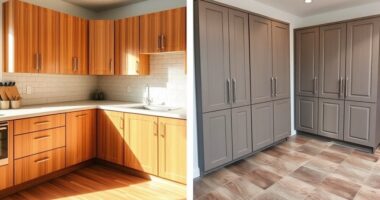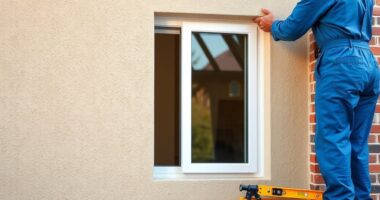To preserve your home’s character while adding comfort, focus on uncovering and maintaining original features like moldings, woodwork, and vintage fixtures with careful restoration. Incorporate modern systems discreetly using hidden wiring and unobtrusive vents, ensuring minimal impact on historic aesthetics. Choose authentic, high-quality materials and subtle upgrades that blend seamlessly with the original style. Collaborate with preservation experts and document every change—this balance of innovation and respect will help you honor your home’s timeless charm for years to come.
Key Takeaways
- Research and preserve original architectural features, such as moldings and fixtures, to maintain the home’s historic character.
- Integrate modern systems like HVAC and smart tech discreetly to enhance comfort without compromising aesthetics.
- Select authentic, high-quality materials and period-appropriate finishes for repairs and updates.
- Use innovative, hidden technology solutions to improve functionality while respecting the home’s vintage charm.
- Collaborate with preservation specialists and document updates to ensure craftsmanship and historical integrity are maintained.

Are you wondering how to thoughtfully update a historic home without compromising its unique character? Achieving this balance requires a meticulous approach that respects the original architecture while integrating modern comforts seamlessly. Begin by thoroughly researching the home’s history, architectural style, and original materials. This knowledge forms the foundation for decisions that honor the building’s integrity. When planning updates, prioritize preserving distinctive features such as intricate moldings, original woodwork, or vintage fixtures. These elements serve as authentic links to the past, so treat them with care during renovations.
Carefully research and preserve authentic features to honor your historic home’s timeless character.
Innovation doesn’t mean abandoning tradition; it involves integrating modern solutions that complement the historic fabric. For instance, consider installing unobtrusive, energy-efficient HVAC systems that do not alter walls or ceilings. Use narrow vents or hidden ductwork to preserve original aesthetics. When updating electrical wiring, opt for concealed wiring methods to maintain the appearance of original wall finishes. In bathrooms and kitchens, retrofit vintage fixtures with modern plumbing that mimics historic styles, ensuring functionality without sacrificing authenticity.
Materials selection is critical. Choose high-quality, historically appropriate materials for repairs and updates. For example, if replacing flooring, look for reclaimed or period-appropriate wood to maintain visual consistency. When updating windows, consider custom-made, energy-efficient replacements that match the original design, preserving both appearance and energy efficiency. Paint colors and finishes should be selected carefully; historically accurate palettes enhance the home’s authenticity, while modern, low-VOC paints contribute to healthier indoor environments.
Incorporate innovative technology thoughtfully. Smart home systems can be integrated discreetly, controlling lighting, security, and climate without disrupting the home’s character. Use hidden wiring or modular components designed to blend seamlessly with existing structures. Lighting fixtures should complement original hardware, or be custom-designed to echo period details, enhancing ambiance while providing modern illumination standards. Additionally, exploring modern building techniques can improve durability and energy efficiency without compromising aesthetic integrity.
Lastly, collaborate with preservation specialists and artisans who understand the nuances of historic architecture. Their expertise ensures that updates are executed with precision, respecting craftsmanship and materials. Document every change meticulously, preserving a record that celebrates the home’s evolution without erasing its history. By combining careful research, high-quality materials, innovative yet discreet technology, and expert craftsmanship, you can breathe new life into your historic home—adding comfort and modernity without sacrificing its cherished character.
Frequently Asked Questions
How Can I Ensure Updates Preserve My Home’s Original Craftsmanship?
To preserve your home’s original craftsmanship while updating, you should consult skilled artisans familiar with historic techniques. Use authentic materials and restore existing features instead of replacing them. Document every change, and prioritize subtle, reversible updates that enhance comfort without compromising character. Incorporate modern innovations thoughtfully, ensuring they blend seamlessly with original details. Regularly assess your work against preservation standards, maintaining the home’s integrity while making it livable.
What Modern Amenities Can Be Integrated Without Damaging Historic Features?
You can seamlessly integrate modern amenities like underfloor heating, recessed lighting, and smart home systems by choosing sleek, unobtrusive designs. Opt for wireless technology to avoid wall damage, and select fixtures that mimic historic styles. Use reversible modifications whenever possible, ensuring updates are non-invasive. Collaborate with preservation specialists to balance innovation with authenticity, maintaining your home’s charm while enhancing comfort with thoughtfully chosen, minimally invasive modern features.
Are There Specific Materials Recommended for Authentic Restoration?
You should choose materials that match the original craftsmanship and period details, such as reclaimed wood, hand-blown glass, and traditional plaster or lime-based paints. Use authentic bricks or stone for masonry repairs, and opt for period-appropriate hardware like brass or wrought iron. For modern updates, select discreet, non-invasive options like low-impact insulation and eco-friendly paints that preserve the home’s character while enhancing comfort.
How Do Local Preservation Laws Impact Renovation Choices?
Like steering a delicate dance, local preservation laws guide your renovation choices carefully. You must adhere to specific guidelines that protect historical integrity, such as using approved materials and maintaining original features. These laws can restrict modern updates, but they also inspire innovative solutions that honor tradition. By working closely with preservation authorities, you guarantee your home’s character remains intact while seamlessly adding comfort and modern functionality.
What Is the Typical Budget Range for Historic Home Updates?
Your budget for historic home updates typically ranges from $30,000 to $150,000, depending on the home’s size, condition, and scope of work. You’ll want to allocate funds for specialized restoration, high-quality materials, and skilled craftsmanship to preserve character while adding modern comforts. Remember, local preservation laws may influence your choices, so plan for potential permits and consultations. Being detail-oriented and innovative guarantees your updates honor history while enhancing everyday living.
Conclusion
By thoughtfully blending preservation with modern comforts, you guarantee your historic home remains both charming and functional. Every update, from restoring intricate woodwork to installing energy-efficient systems, preserves its unique character while embracing innovation. Remember, you’re not just patching holes but safeguarding a legacy; it’s a delicate dance. When you strike the right balance, you breathe new life into the past, proving that you can have your cake and eat it too without losing sight of what makes your home special.









